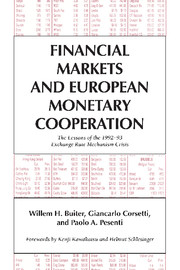 Financial Markets and European Monetary Cooperation
Financial Markets and European Monetary Cooperation Published online by Cambridge University Press: 06 July 2010
Exchange rate crises and speculative attacks
In the aftermath of the 1992–93 events, there has been a revival of academic interest in analyzing and modelling the timing and determinants of currency crises and speculative attacks on fixed exchange rate regimes. Many recent contributions offer valuable elements for an interpretation of the logic of the ERM crisis. Informed by the historical reconstruction presented in the previous chapters, we now provide a synthetic survey of the current literature. This also lays the groundwork for our own theoretical construction in Chapters 6, 7, and 8.
Exogenous and endogenous policies
There exist two approaches to modelling exchange rate crises. The first approach, pioneered by Krugman (1979), focuses on the timing and the mechanics of a speculative attack when national authorities pursue policies that are inconsistent with the indefinite defense of the exchange rate parity. The second approach looks at optimizing policymakers who are assumed to have good reasons to peg the currency – for example, because a peg is seen as a commitment technology for reducing the undesirable consequences of an inflationary bias – but not at any price. They may, therefore, find it optimal to abandon the exchange rate parity under certain circumstances. Throughout this chapter, we will label the two modelling strategies as, respectively, the “exogenous-policy” and the “endogenous-policy” approach.
In Krugman's model, domestic credit expansion persistently exceeds the growth of money demand at a fixed exchange rate.
To save this book to your Kindle, first ensure [email protected] is added to your Approved Personal Document E-mail List under your Personal Document Settings on the Manage Your Content and Devices page of your Amazon account. Then enter the ‘name’ part of your Kindle email address below. Find out more about saving to your Kindle.
Note you can select to save to either the @free.kindle.com or @kindle.com variations. ‘@free.kindle.com’ emails are free but can only be saved to your device when it is connected to wi-fi. ‘@kindle.com’ emails can be delivered even when you are not connected to wi-fi, but note that service fees apply.
Find out more about the Kindle Personal Document Service.
To save content items to your account, please confirm that you agree to abide by our usage policies. If this is the first time you use this feature, you will be asked to authorise Cambridge Core to connect with your account. Find out more about saving content to Dropbox.
To save content items to your account, please confirm that you agree to abide by our usage policies. If this is the first time you use this feature, you will be asked to authorise Cambridge Core to connect with your account. Find out more about saving content to Google Drive.